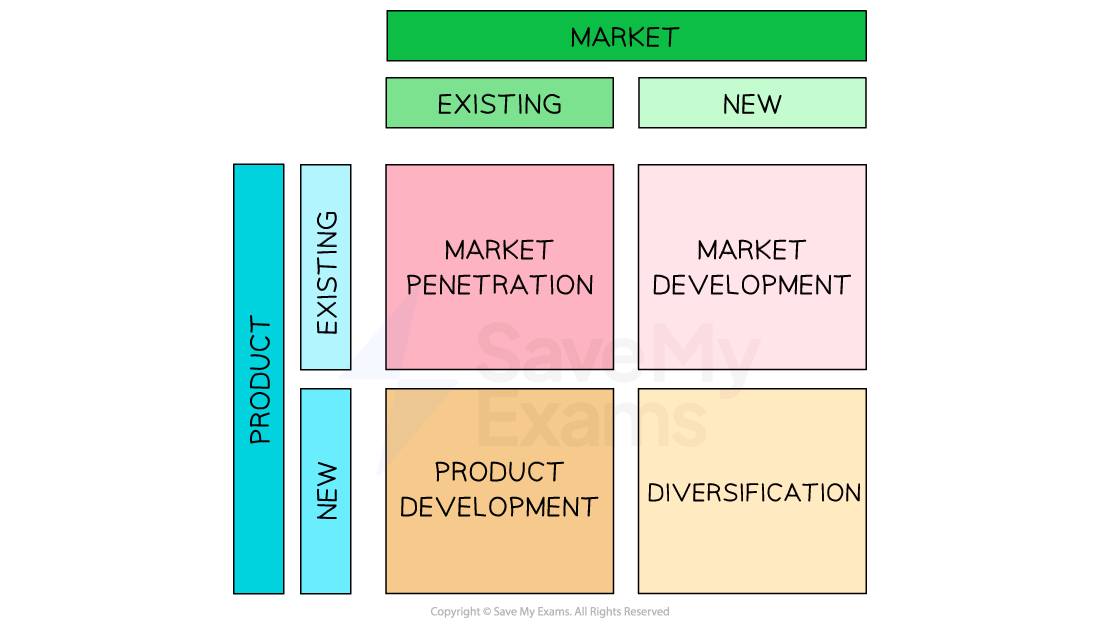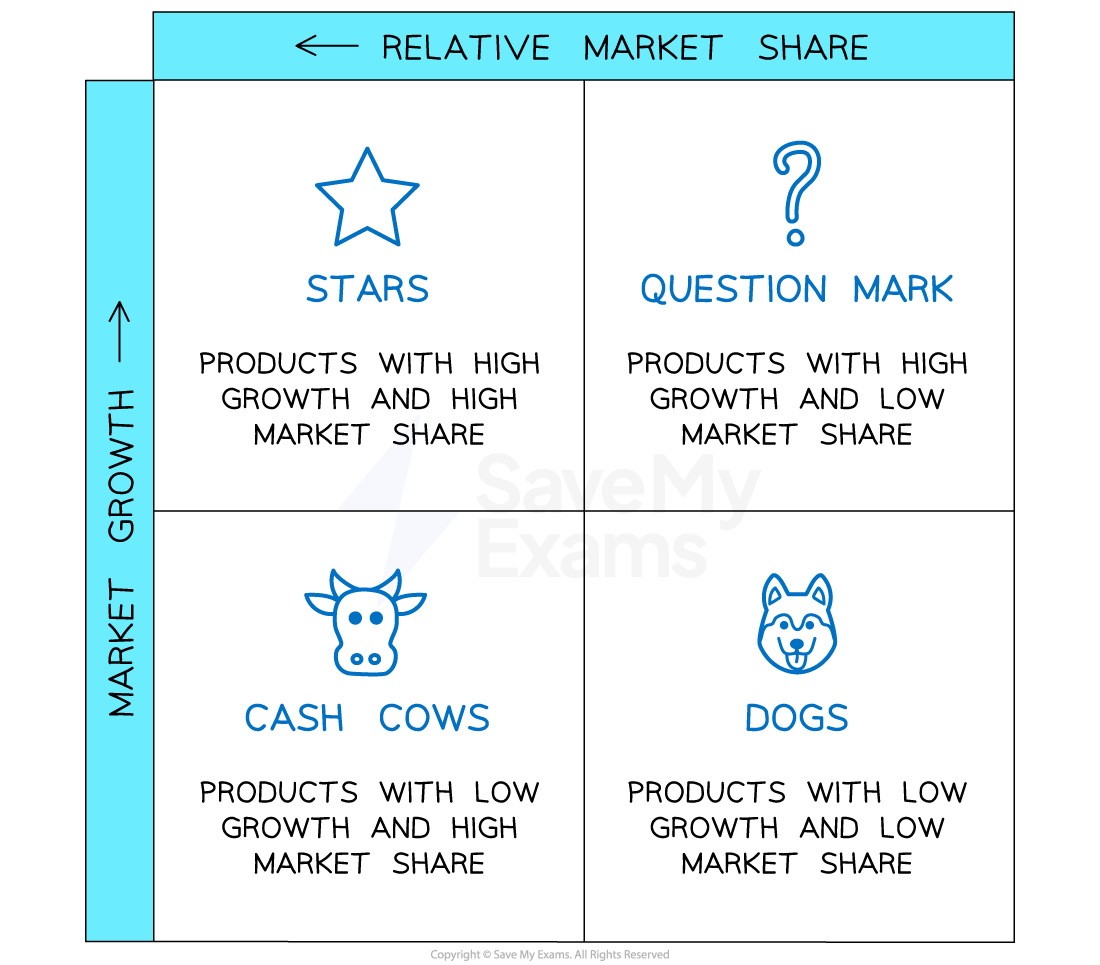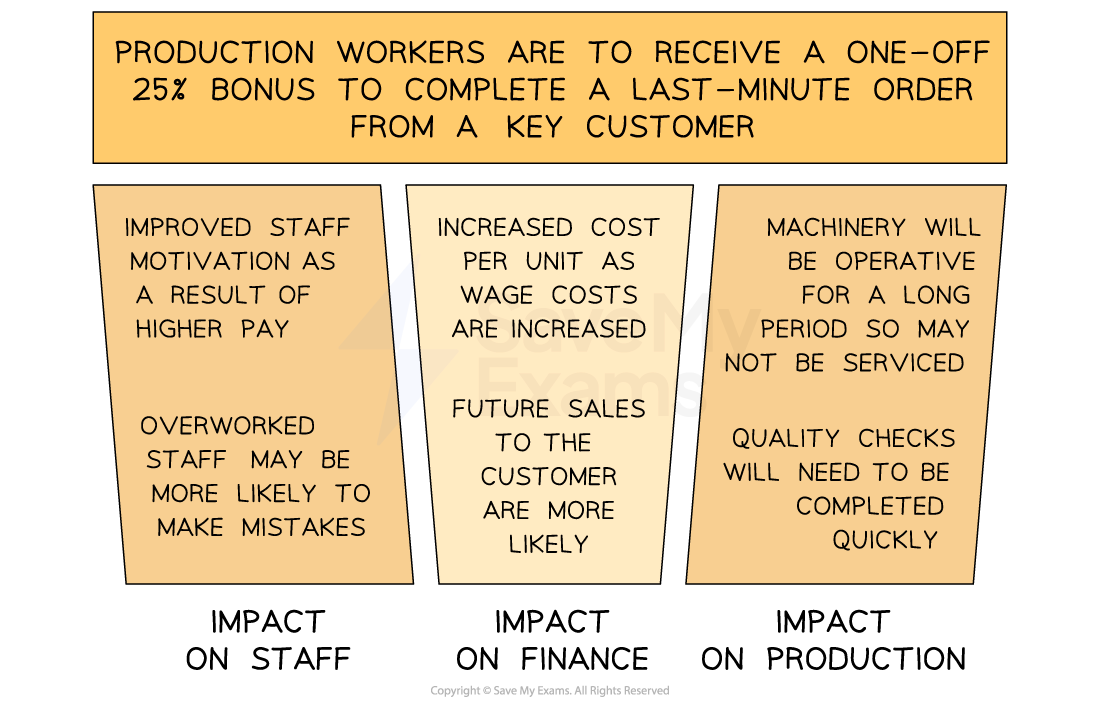Theories of Corporate Strategy (Edexcel A Level Business): Revision Note
Exam code: 9BS0
Development of corporate strategy
A successful corporate strategy helps to provide a competitive advantage
Effective corporate strategy development requires careful consideration of a range of internal factors and the external environment in which the business operates
Internal factors include the human and capital resources available
External factors include the economic and political environments
Two strategic models used to develop a corporate strategy are the Ansoff matrix and Porter's strategic matrix
The Ansoff matrix
The Ansoff matrix is a tool for businesses with a growth objective
It is used to identify an appropriate corporate strategy and the level of risk associated with the chosen strategy
The model considers four elements, which are broken down into two categories:
The market — existing and new markets
The product — existing and new products
The Ansoff matrix: strategies for growth

The least risky strategy to achieve growth is to pursue a strategy of market penetration
This involves selling more products to existing customers by encouraging:
More regular use of the product
Increased use of the product
Brand loyalty of customers
Market development involves finding and exploiting new market opportunities for existing products by:
Entering new markets at home or abroad
Repositioning the product by selling to different customer profiles (selling to other businesses as well as directly to consumers)
Seeking complementary locations
For example, M&S Food has achieved significant growth since teaming up with fuel retailers such as BP and Applegreen and providing express retail outlets
Product development involves selling new or improved products to existing customers by:
Developing new versions or upgrades of existing successful products
Redesigning packaging and aesthetic features
Relaunching heritage products at commercially convenient intervals
For example, Cadbury relaunches Christmas-themed products each year, often with a subtle design change, to recapture the interest of customers
Diversification is the most risky growth strategy, as it involves targeting new customers with entirely new or redeveloped products
Examples of diversification include:
Tesco launching a range of financial products, including current accounts and credit cards
Greggs launching a range of themed clothing products
Porter’s generic strategic matrix
Porter’s generic strategic matrix identifies a range of strategies a business might adopt, considering:
Its source of competitive advantage (cost or differentiation)
The scope of the market in which it operates (mass or niche)
Porter argues that failing to adopt one of these strategies risks a business being "stuck in the middle" and unable to compete successfully with rivals in the market
Porter's generic matrix

Businesses operating in the mass market should adopt either a cost leadership or a differentiation strategy, depending on what it is that makes them stand out from their competitors
Businesses that have a significant cost advantage over competitors should exploit this as much as possible to achieve success, which is called cost leadership
Businesses that are unable to operate as the most competitive on cost should adopt a strategy of differentiation
A business that operates in a niche market should adopt a focus strategy that closely meets the needs of its specific group of customers
A cost focus involves being the lowest cost competitor within the market niche
A differentiation focus involves offering specialised products within the niche market
Portfolio analysis
Portfolio analysis involves a business carrying out a detailed evaluation of its full range of products so that appropriate strategies may be identified and pursued
Boston matrix
The Boston Matrix is a portfolio analysis tool that considers the relative market share of a firm's products and the rate of growth within the market in which each product is sold

Stars are products sold in high-growth markets and have a high level of market share
Stars require some ongoing investment to maintain their market position and, if managed well, they are likely to become cash cows in the future
A market penetration strategy to increase sales revenue and maximise market share is likely to be appropriate
Cash cows are sold in lower-growth markets and have a high market share
Cash cows generate more cash than they need to maintain their market position and can be used to fund the development of other products in the portfolio
Businesses may seek new markets for these products if they are relatively risk-free
Question marks are sold in high-growth markets and have a relatively low market share
Question marks require significant investment if they are to improve their level of market share and become stars
There is a risk that question marks will become dogs when market growth rates slow
Dogs are sold in low-growth markets and have a relatively low market share
Dogs have little potential for future growth and should be divested so that finance and effort may be invested in other products
Achieving competitive advantage through distinctive capabilities
When a business has a particular strength that is very difficult for competitors to copy, it has a distinctive capability
The nature of that distinctive capability will determine the aims and objectives of the business and the strategies it will pursue to achieve them
Examples of distinctive capabilities
Distinctive capability | Explanation |
|---|---|
|
|
|
|
|
|
|
|
The effects of strategic decisions on resources
Strategic decision-making involves medium- to long-term planning to achieve corporate and functional objectives
It establishes the actions that the business intends to take to achieve its goals
Strategic decision-making will have an impact on a business's human, financial and production resources
Examples of the impact of strategic decisions on resources
Enter a new overseas market
Impact on human resources | Impact on financial resources | Impact on production resources |
|---|---|---|
|
|
|
Withdraw an obsolete product from sale
Impact on human resources | Impact on financial resources | Impact on production resources |
|---|---|---|
|
|
|
Merge with a competitor
Impact on human resources | Impact on financial resources | Impact on production resources |
|---|---|---|
|
|
|
Examples of the impact of tactical decisions on resources
Tactical decisions are made to support the overall strategy and are usually short-term
Tactical decision-making will also have an impact on a business's human, financial and production resources
Awarding a bonus to workers

Decoration of business premises

Examiner Tips and Tricks
You should be able to distinguish between strategic and tactical decisions in a business context and make judgements about whether the distinction is useful in business.
Strategy is more long-term and relates to achieving an overall goal; tactics are shorter-term actions that help to achieve the strategy.

Unlock more, it's free!
Did this page help you?